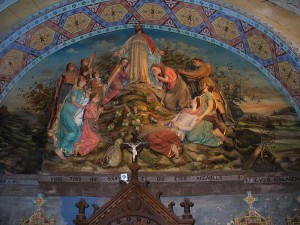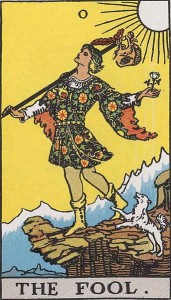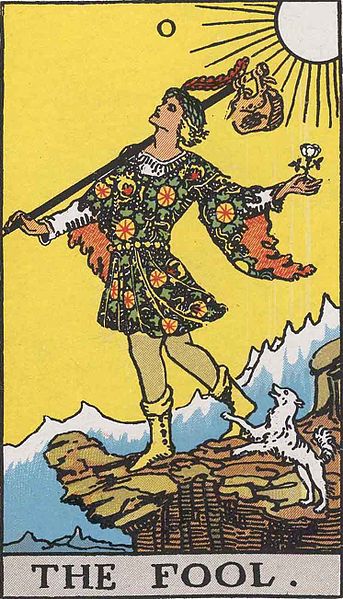 The clues of the Maranatha Puzzle offered many different interpretations for puzzlers. Each person considering the cluster of words followed various paths and researched numerous options. It was possible any of them, each in their own way, could have led a person to a final intended conclusion. The clue’s understandings, much like the enigma’s noticed at Rennes le Chateau, are still questioned today. Only speculations, like the following, can be shared.
The clues of the Maranatha Puzzle offered many different interpretations for puzzlers. Each person considering the cluster of words followed various paths and researched numerous options. It was possible any of them, each in their own way, could have led a person to a final intended conclusion. The clue’s understandings, much like the enigma’s noticed at Rennes le Chateau, are still questioned today. Only speculations, like the following, can be shared.
While exploring the September 2007 clue of ‘Find in a burden’s name the rod not to use, just as the artist cast it away’, puzzlers were led down many paths. It has been realized how even searching for an understanding of only one clue, picked from the entire collection, could send a person on a journey.
One potential meaning for the first half of the clue led to Find in the Ark of the Covenant (symbolically); as explained in a previous post. This may connect to the second half by signifying a particular time.
‘Just as’ is a synonym for ‘at the same time’. The second half of the clue could then be read as ‘at the same time as the artist cast it away’? In the Maranatha Puzzle book, the artist of the seven images had signed his name to all, except one. The ‘it’ of the clue segment could refer back to ‘name’ in the first half of the clue. Scaramouche (the artist) cast his name away on the fifth image of the book. This picture shows two serpents and a staff entwined.
An interpretation can be made that the time in which the artist cast his name away was at the precise time or point of unity displayed on the page. The two serpents represent opposites. The staff provides a point of balance of which the two intersected. The image portrays a time of union and demonstrates a point of spiritual awakening.
If ‘the rod not to use’ is ‘Aaron’s rod’(the rod which budded/renewed life), perhaps a meaning of the complete clue is indicating life is found at a ‘point of unity’. The rod, symbolizing man, is laid to rest once life is found. Matthew 16:25 states, “For whomever wants to save his life will lose it, but whoever loses his life for me will find it.”
 Fascinatingly, there is another artist who cast a rod away and may offer an additional application with a similar meaning. One found not directly in the book. Because the ‘artist’s’ name of the Maranatha puzzle book was linked to the Fool (Scaramouch), the cast away rod could have been the fool’s rod. Since Puzzlers were informed during the competition that the ‘secret’ found within the puzzle was connected to the mystery surrounding Rennes le Chateau, one may have looked there for a cast away fool’s rod. The fool’s rod is often seen with a sack.
Fascinatingly, there is another artist who cast a rod away and may offer an additional application with a similar meaning. One found not directly in the book. Because the ‘artist’s’ name of the Maranatha puzzle book was linked to the Fool (Scaramouch), the cast away rod could have been the fool’s rod. Since Puzzlers were informed during the competition that the ‘secret’ found within the puzzle was connected to the mystery surrounding Rennes le Chateau, one may have looked there for a cast away fool’s rod. The fool’s rod is often seen with a sack.
There happens to be an occasion. In the large bas relief depicting Jesus on the Mount, there is a prominent sack located front and center. As described on the RLC Research Site, the painting was most likely inspired from a previous picture in an 1875 book by Dean Frederic Farrar called ‘Life of Christ’. In the original picture there was a rod depicted with the sack. However, at Rennes le Chateau, the ‘rod is cast away’ by the artist; it does not appear. One may wonder if the clue wanted to draw attention to the scene in which the rod does not appear along side of the sack.
Like the image in the Maranatha book, this image of Jesus standing above offers an understanding of Unity. The below caption says, “Come to me, all who suffer, and I will relieve your pain” (translation). The similar phrase in the Bible is “Come to me, all you who are weary and burdened, and I will give you rest.”(Matthew 11:28) Jesus, seen as Divine, provides the union of opposites; man and God. A new covenant.
The side scenes display another hint towards union of opposites. They are opposite landscapes as described again on the RLC site. Together, the phrases beneath each side and one wide reaching arc complete the thought, “Come to me and I will give you rest.” The possessions/burdens of man (fool’s sack) are seen placed aside, and the unseen rod could be seen as laid to rest/not used; perhaps signifying a raised man.


I think the burden always referred to the story of Sisyphus. The part about the artist casting it away might be steering us to eliminate the mid-part of a word or string of letters (ti are the two middle letters in artist). Since a big focus of the puzzle was on SIS, we might be getting instructed to toss out the “rod” between the two Ss. Maybe part of the solution involves removing something between two snake-like structures.
Thanks for your comment, Eliza. Great thoughts. So many paths-I am glad we have a lifetime.
other foods for thought:
“First harken to David the astrologer for as he rests his staff next to his sons he points to the centre of the heavenly spheres and draws their frozen music.” rests/cast away? Since he draws, does this make him an artist?
I lean more towards Flamel though:
“In the end, having lost all hope of ever understanding those figures, for my last refuge I made a vow to God and St. James of Gallicia, to demand the interpretation of them at some Jewish Priest in some Synagogue of Spain. whereupon, with the consent of Perrenella, carrying with me the Extract of the Pictures, having taken the Pilgrims’ habit and staff, in the same fashion as you may see me without this same Arch, in the Church-yard in the which I put these Hieroglyphical Figures, where I have also set against the wall, on the one and the other side, a Procession, in which are represented by order all the colours of the Stone, so as they come and go, with this writing in French: Much pleaseth God procession, If it be done in devotion.”
just need to find where he cast it away…
Awesome HappyThoth. I had forgotten about Flamel’s staff mentioned in the introduction. Thanks for the additional info about it. Of course we also have in the text about ‘look to the armoured King of Terrors see him cast away a pilgrim’s staff’. By the time we are done collecting and casting away staffs, we will have enough for a bonfire.
Pingback: A Journey - Page 1170
“Just as the artist cast it away” refers to the rock of Sion, mentioned several times in the Bible. Psalm 118:22 “The stone which the builders refused is become the head stone of the corner.”
I agree that the rod not to use is the fool’s rod. Not sure that there’s any fool’s rod in Rennes le Chateau, though.
Then, looking more carefully at the picture, the figure to the left does have a staff, and it’s pointing straight at the centre of one of the hexagons of the arch. But does the sack not far away mean that it’s a fool’s staff?
There is another curious thing, on the right side a leaning long piece of wood or stone. And something next to it that I can’t really identify. Any notion on what that is?